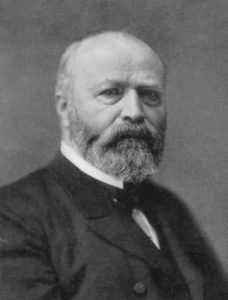
Hot evidence in a cold case
New evidence in a 130-year-old unexplained death? It’s unusual, but it can happen.
In the case of the mysterious death of Bavaria’s King Ludwig II, the new evidence takes the form of Dr. Gudden’s death mask. Munich’s Rosenheim Museum rediscovered it in its attic in 1999. The mask tells a story that casts new light on Ludwig’s death.
Bavaria’s greatest unsolved mystery
Just how did King Ludwig II die on 13 June 1886? No one knows for sure.
The Bavarian government had just deposed the 40-year-old king as unfit to rule and placed him under guard at Bavaria’s Castle Berg on the shores of Lake Starnberg. Following an evening walk on the lakeshore, Ludwig and Dr. Bernhard von Gudden, Bavaria’s best-known psychiatry professor and expert witness in the proceedings to depose the king, were found floating face-down in the waist-deep waters of the lake. No one witnessed their deaths; no one knew exactly what happened.
Autopsy results on the king found no cause of death. There was no water in his lungs and no visible mortal injury – just a scrape on his knee. Theories about the deaths have spiraled out to suicide, homicide, and various forms of an accident. You can read more about the mysterious case here, and for the reasons many Bavarians think it was murder, click here.
The Bavarian government’s official explanation
The Bavarian government’s official explanation for the deaths was homicide-suicide. King Ludwig II rushed into the lake to commit suicide. When Dr. Guddden tried to stop him, Ludwig killed him. Then he waded out into deeper waters to drown himself.
The problem with this theory is that two pieces of evidence – the men’s pocket watches and Dr. Gudden’s death mask – bear silent witness to the contrary.

The riddle of the pocket watches
King Ludwig’s pocket watch stopped at 6:54 pm. If the government’s theory were true, you’d expect Dr. Gudden’s watch to have stopped earlier because he would have been floating in the water longer than King Ludwig II.
The reverse, however, is true. Dr. Gudden’s watch stopped at 8:06 pm – 72 minutes after the king’s watch did. This discrepancy is one of the most hotly debated aspects of the case.
Once water enters a pocket watch’s machinery, it will stop very quickly. In a televised experiment for a German documentary, a watchmaker dropped a replica of a 19th-century pocket watch into a glass of water. It stopped after 20 seconds.
Various theories have been advanced to explain why the discrepancy might still be consistent with the government version. According to one, Dr. Gudden often forgot to wind his watch. Hence, it may have been running too fast or slow. Likewise, historians have argued the king habitually set his watch back a half hour or more.
The doctor was known to close his watch lid very tightly, and that might have affected how quickly water entered the watch’s gears. Furthermore, Ludwig wore less clothing – only a shirt and vest – when he entered Lake Starnberg. He had stripped off his jacket and greatcoat first, but Dr. Gudden kept on his. Thus, it would have taken the water longer to saturate Dr. Gudden’s outer clothing and reach the watch.
But would it really take 72 minutes?
It’s hard to know which version to believe. Fortunately, there was a third clock ticking, a biological one – one whose accuracy could not be influenced by human maintenance or clothing. That clock, visible on Dr. Gudden’s death mask, sets the pocket watch discrepancy in a new light.

Dr. Gudden’s death mask
For decades, Dr. Gudden’s death mask disappeared among stored and boxed items of the Rosenheim Museum in Munich. A worker rediscovered it in 1999 and it became the subject of an exhibition in 2014.
The mask shows injury to Dr. Gudden’s face. His right eye – the left one from the viewer’s perspective – is visibly swollen. The Rosenheim Museum could not provide me with an image I could use for this post, but you can view the swelling in this German talk show by forwarding to 2:13-17.
The eye injury on Dr. Gudden’s death mask is consistent with descriptions of Gudden’s face following his death. Dr. Heiß, the substitute district physician who assisted the investigating magistrate, noted blue coloring under the right eye and frontal eminence of the brow which appeared to be caused by a heavy blow from a fist. Two government officials described swelling above Dr. Gudden’s left eye (they probably meant left from their perspective). The psychiatry professor Dr. Grashey recorded a broad contusion on the right frontal eminence. Dr. Müller, Gudden’s assistant, noted “not insignificant” blue coloring, over the right eye, which he also thought might have been caused by a fist. Finally, a district commissioner made a similar observation. He found indications of a blow to Dr. Gudden’s right brow.
Antemortem, perimortem, or postmortem?
A pathologist today would try to categorize Dr. Gudden’s bruising according to when it happened – before, at the time of, or after his death. Generally speaking, injuries received before death show swelling. Once the circulatory system stops at death, injuries are less likely to swell. This means Dr. Gudden might have survived the blow to his eye for a period of time before he died. And that would underscore the pocket watch discrepancy.
But there are exceptions. Certain postmortem conditions can cause pseudo-bruising, lending an antemortem appearance to a postmortem injury. One such condition is the position of the body. Dr. Gudden floated face-down in the water for two to three hours before he was found, allowing blood to pool in his face. That pooling might have caused some swelling even after death. He was laid in a supine position after he was found, and that might have reserved the effects by the next day.
Whether Dr. Gudden’s death mask and the descriptions of his injury are enough to pinpoint the time of injury is an issue for a pathologist. Strangely, I’ve found nothing in the literature indicating that Ludwig or Gudden historians have ever approached a pathologist with this question. It’s an important one, because if Dr. Gudden survived his presumed fight with the king for any period of time, the government explanation starts to crumble and the watch discrepancy takes on a new significance.
A British television producer interviewed me about this case in October 2016. I suggested the team take this question to a pathologist. The episode will air in April or May with UKTV as part of a series called “Royal Murder Mysteries,” and with luck, it will also air on the Discovery Channel in the U.S. I’ll be looking forward to seeing if an expert addresses Dr. Gudden’s death mask.

Literature on point:
“Akte Mord – Historische Kriminalfälle,” Welt der Wunder Wissensthek (Schröder Media, 2008), DVD.
“Das Geheimnis der verschollenen Totenmaske,” OVB online (13 May 2014).
“König Ludwig II & Bernhard von Gudden – Stadtgespräch München,” München-TV (10 July 2015).
“Ludwigs letzte Sekunden: Bei der Bestimmung des Todeszeitpunktes hat Uhr des Königs geholfen. Rätsel bleiben ,” Augsburger Allgemeine Zeitung (11 July 2011).
C. McIntosh, The Swan King: Ludwig II of Bavaria (I.B. Taurus, rev. ed. 2012).
J.P. Saxena, “Medico-Legal Significance of Bruise,” Legal Service India (2000-2015).
Alfrons Schweigert, Der Mann, der mit Ludwig II starb: Dr. Bernhard von Gudden, Gutachter des bayerischen Königs (Husum Druck- und Verlagsgesellschaft, 2014).
Vanezis, “Interpreting Bruises at Necropsy,” J. Clin. Pathol 54:348-355 (2001).




I hope that show will be available in the U.S. I’d love to see it!
I hope so too, Undine! And wouldn’t it be fun if someone also did a documentary on Ludwig II and Edgar Allan Poe?
I would love to see it too. What a fascinating post.
Thank you, Susan! Is your book out yet?
Great post. I visited Neuschwanstein in 2014 when I was in Munich for Oktoberfest. The mystery of Ludwig’s death is quite fascinating indeed.
Thanks, Jeri. I’m glad you enjoyed your visit to Bavaria and got to enjoy other aspects of its culture besides one of its most enduring mysteries. The Oktoberfest is definitely a unique cultural phenomenon.
Until I see a scientific report of dna analysis from the body of Ludwig II confirming it really is him, I’m open to the suspicion the body was that of a royal double. Considering the amount of assassinations going on in the period, a double or triple would be a safe requirement, I have to raise this possibility.
That’s an interesting point, Glock, and an explanation I haven’t seen raised before. If the body was a double, what do you think happened to the real Ludwig II? Did he go into exile and live in obscurity? Did the murderers think they were killing the real king? The possibility of a double raises some interesting questions. There are a number of Bavarians pushing for examination of the body, and should that ever happen, we would get some answers to questions like yours. Thanks for commenting.
I can speculate (using imagination) that he’d possibly have gone two routes, to an incognito life of arts and crafts or to Sissi’s side – he was mainly nocturnal from my reading of his habits, so I’d like to wildly suggest some clues from where Sissi resided, prior to Ludwig’s death date. In 1881 & 1882 Sissi stayed at Combermere Abbey in England, where she had a staircase built to connect her chambers with the kitchen. This was suggested to be so that she could eat meals at night, something that I have to question because she had a very energetic daytime and a tiny (20″ waist?) so I have ideas that they might have met up under concealment on their tours. Ludwig did tour England, roaming for architectural ideas, I don’t know if his official tour date coincided with her stays in England. I admit, I’m off into the realms of fantasy now, though I do feel that sometimes breakthroughs can come from such dalliance. The key would be no doubt to look for tall, equestrian men with untracable or vague titles that were seen with her too often to be normal. Salutations from Kent, WA.
Those are some interesting ideas, Glock. I’ll have to check my Ludwig diary about a tour to England and when it happened. I hadn’t been aware of the tour — or have forgotten about it. Salutations from a rainy Germany from a person who used to live in Seattle and knows Kent.
Very interresting..I always wondered about this. Been to the Starnberger See near Munich..and thaught about these mysterious deaths often. I heard they were both Lovers and committed suicide together. We thank King Ludwig for all the beautiful castles..we visited all of them. Mayor tourists attraction now and so incredible beautiful.?????
I haven’t heard the theory of the two being lovers. don’t think King Ludwig and Dr. Gudden had even met before Ludwig was taken into custody, so I doubt it was true. I have also been to Starnberger See and I agree, it’s beautiful!